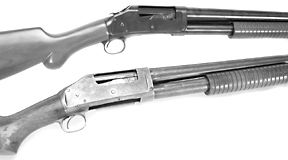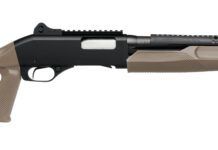
The initial birthing of the Winchester Model 1897 shotgun proved to be a difficult delivery. Though this particular version of the gun appeared in November of its namesake year, it had been conceived, at least in part, seven years earlier when Winchester Repeating Arms bought a patent from John Browning. The patent was for an exposed-hammer slide-action firearm that first became the Winchester Repeating Shotgun Model 1893.
But the 1893 didn’t last long because it wasn’t built to handle smokeless shells. Winchester revamped the shotgun and relaunched the solid-frame product as the 1897. A little more than a year later, the company added a 12-gauge takedown version of the 1897.
The 1897 was officially discontinued in 1957, when the series’s serial numbers climbed above 1 million. But the old design has had new life breathed into it recently as shooters search for affordable Cowboy Action guns. The Cowboy game emphasizes turn-of-the-century period accuracy, which the 1897, of course, supplies.
We recently had a chance to shoot two original Winchester versions of the 1897 (one solid frame and one takedown) against a newly introduced Chinese copy of the 1897 from Norinco.
The takedown model used in our test was manufactured in 1940 and the solid frame in 1938. The Blue Book of Gun Values (22nd Edition, [952] 854-5229) says the range of prices for the guns runs from $125 for guns in 10-percent condition to $850 for guns in 100-percent condition. We paid $300 for the solid-frame Winchester 1897 and $320 for the breakdown gun. The Norinco 97, in contrast, cost only $220, though it MSRPs for $349.
The niche the Norinco gun seems to be seeking to supply is producing an affordable, modern alternative to the 1897s, and we learned it proved true to the Winchester design without many of the downsides of owning an older gun — such as iffy pressure restrictions.
The original model 97s allowed the use of 2.75-inch smokeless shells. However, it is recommended that only low-brass standard field loads be used in the shotguns. Also, a small number of model 97 shotguns were produced with Damascus barrels up until 1914; they should not be used with modern smokeless powder at all.
Range Session
We fired these guns at a variety of stationary and moving targets, looking primarily for how well they would work in Cowboy venues. That means slick, smooth handling was at a premium, and that patterning was less of a factor. Right away, we noticed that in terms of handling, the Norinco would have a decided edge, since it is available in a 20-inch barrel, and measured only 37.5 inches overall. The two Winchesters had standard 30-inch tubes.
Still, we patterned the trio just to see how the fixed tubes delivered shot charges. Our test ammos were Winchester AA Light Target loads, Estate Light Targets, and Estate Dove & Quail loads. As we noted previously, we chose light loads to ensure the older Winchesters weren’t overpressured, but also because shooting close targets in the Cowboy game doesn’t require much power or shot. Here’s what we thought of the guns after shooting them:
Winchester Model 1897 Solid-Frame Shotgun, $300
Winchester Model 1897 Takedown Shotgun, $320
Several configurations of the Model 1897 were offered by Winchester. They included field grade, tournament grade, special trap grade, pigeon grade, brush gun, riot gun, and trench gun styles. Field-grade shotguns in 12 gauge with 30-inch Full-choke barrels are the most common, and that’s what we tested. To be most effective at the Cowboy game, we think the owner would have to truncate this gun’s long tube with a hacksaw, which would damage its collectible value. (A better option is to hire a gunsmith to shorten the barrel down to 18 inches and open the choke from Full to Cylinder. Yet another option is to locate one of the Model 97 trench guns used by the U.S. Army in World War I. However, they are hard to come by and usually sell for several thousand dollars. A third option is to hunt for a harder-to-find 1897 Riot gun, which will cost about $300, depending on quality.)
[PDFCAP(1)]When shopping for a Winchester 97 at your local gun show, it is important to determine whether the shotgun you are looking at is a takedown model or not. The takedown model allows you to easily remove the magazine tube and barrel. If you locate another barrel with a different choke and/or another barrel of a different length, then you can switch them out as you wish.
One thing to watch for when selecting a takedown model is the tightness of the connection between the receiver and the adjoining barrel/magazine. The more play there is in this area, the more worn out the threads are on the barrel. There is a serial number on the bottom side of the receiver and on the barrel/magazine section. It enhances collector value and increases the chances of a good fit if both serial numbers match. Get the seller to show you how to take off the barrel and magazine and inspect the threads.
Further disassembly is complicated, and we don’t recommend it. If you like to take the bolt out of your shotgun to clean it thoroughly, you would do well to consider another model of shotgun.
The Winchester Model 1897 is the shotgun of choice for many Cowboy Action shooters. Generally, Cowboy shooters prefer a 20-inch barrel with Cylinder choke because they are shooting at stationary steel targets 10 to 15 yards away. However, the model with a 30-inch barrel and Full choke could certainly be used for this competition, allowing the gun to do double duty for taking game. They’d make good pass-shooting guns in their current configurations, except they won’t handle heavy or magnum shot loads.
Despite wear, the actions on our test guns were rough and required judiciously applied force to cycle the actions. To open either gun, the shooter pushes in the action slide lock release plunger pin, located on the right rear side of the receiver. This unlocks the action and allows the slide to work. In both cases, it was hard to get the slide going once the pin was depressed. When we were shooting clays with the gun (and likewise for hunting), we found it was easier to load one round in the chamber and put the hammer down, loading subsquent rounds into the magazine tube from the bottom. Then when it was time to shoot, we cocked the hammer for the first shot, then cycled the gun for the followups. Of course, this solution wouldn’t work for competitive situations in which the gun must start empty and open. Neither gun had a safety, though the hammer could sit at half cock.
Surprisingly, the triggers on these guns broke cleanly, and in one case, not too heavily. The solid-frame 1897 broke at a paltry 2.5 pounds, one of the best shotgun triggers we’ve ever tested in terms of weight. It had a little take-up before release, however. The takedown gun, in contrast, broke at 7 pounds, with negligible creep.
We won’t spend too much time commenting on the cosmetics and finish of these guns, except to say that quality varies. The metal finishes on both guns needed reblueing, and the stocks on both showed some wear and tear. How much of this “character” you would want on your own gun is a matter of taste, if you wanted a feeling of authenticity to go with your hat and spurs.
Of the pair, we didn’t see much difference in the overall mechanical function of them at the range. Both of them were fairly balky to operate, and the shooter needed to move the slide vigorously to cycle the action. But the takedown feature gives one gun the advantage, in our view. It’s easy to cut the overall size of the takedown gun in half by pushing on the magazine locking pin, turning and freeing the magazine plug, and sliding the barrel off the receiver.
Norinco Model 97, $220
This gun is made in China and is a close copy of the Winchester Model 1897, but many of the parts do not interchange with the Winchester, we found. The stock is hardwood, unlike the straight-grain walnuts on both of the original Winchesters.
[PDFCAP(2)]Also, the shape of the stock is slightly different than the Winchesters, featuring less drop at the comb and heel and a rounded, more sloping grip. The grip was very slick when oil or sweat were present, since the buttstock had no texturing.
The action was less stiff than the Winchesters, with the action-release button operating much more positively. The racking action was also more compact, measuring 3.5 inches for the Norinco, versus 3.75 inches for the Winchesters. As you might expect, the slide action was tighter on the new gun than on the Winchesters.
Mounting the Norinco, open action, unloaded from a table and firing two shots at ground-level targets exposed some problems with the gun. The slick plastic buttpad scooted right past the shoulder on many occasions, whacking the shooter’s cheek with the stock. Or, if the gun mounted too high, the very sharp buttplate toe could dig into the shooter’s shoulder. Neither were enjoyable experiences, even with light loads.
Still, we thought the Riot configuration of the Norinco was, overall, better and faster than the comparable Winchesters, mainly because of the shorter barrel and lighter weight. As we noted, cycling the action was faster, but the underside edges of the Norinco’s bolt were sharp, and it would be no problem to rack the slide and cut the top of your thumb. If you bought this gun, it might be worth having a gunsmith take those edges off, if it didn’t damage the gun’s function. Otherwise, you either have to learn to position your grip hand properly or wear leather gloves.
Gun Tests Recommends
Winchester Model 1897 solid-frame shotgun, $300. Don’t Buy. Even though the gun is functional enough, the takedown is the better value, depending on the condition of samples you find.
Winchester Model 1897 takedown shotgun, $320. Conditional Buy. Cowboy enthusiasts will pay a premium for authenticity, and for them, an actual working version of this pumpgun is worth the hassles of making it better suited for their favorite game. The 30-inch gun has too much mass out front to point fast, so it would need to be shortened to something nearer the 20-inch-length of the Norinco’s barrel, in our view. Or you could simply muddle through as best you can.
Norinco 97, $220. Best Buy. This is a quick, relatively inexpensive way to get a period shotgun suitable for Cowboy shooting. It is not without its flaws, but you can ride it hard and put it up wet, and not have to worry about devaluing an original classic. As important, the Norinco 97 can typically be found for 25 to 50 percent less than a Winchester in good condition.
































